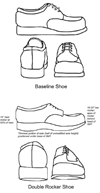Biomechanics of the double rocker sole shoe: gait kinematics and kinetics
- PMID: 17271467
- PMCID: PMC2211387
- DOI: 10.1109/IEMBS.2004.1404411
Biomechanics of the double rocker sole shoe: gait kinematics and kinetics
Abstract
This paper reports the kinematic and kinetic changes in gait with bilateral double rocker sole shoe modifications. Three-dimensional motion analysis techniques were used to evaluate gait characteristics (temporal-spatial, kinematic, and kinetic measures) of forty (40) subjects while wearing baseline and double rocker sole shoes. Walking speed was unchanged by the double rocker modification. Sagittal plane motions showed significant change at the pelvis, hip, knee, and ankle. (p = 0.01). The toe-only rocker consistently resulted in increase in posterior pelvic tilt (p =0.01). Kinetic changes were observed at the hip in the sagittal and transverse planes, and at the knee and ankle in the sagittal planes. Changes in pelvic tilt and hip rotation were hypothesized to result from feelings of imbalance during ambulation with the double rocker sole shoe.
Figures






Similar articles
-
Biomechanical implications of the negative heel rocker sole shoe: gait kinematics and kinetics.Gait Posture. 2006 Nov;24(3):323-30. doi: 10.1016/j.gaitpost.2005.10.006. Epub 2005 Nov 21. Gait Posture. 2006. PMID: 16300949
-
Biomechanics of the double rocker sole shoe: gait kinematics and kinetics.J Biomech. 2007;40(13):2882-90. doi: 10.1016/j.jbiomech.2007.03.009. Epub 2007 Apr 30. J Biomech. 2007. PMID: 17467718 Clinical Trial.
-
Effects of the toe-only rocker on gait kinematics and kinetics in able-bodied persons.IEEE Trans Neural Syst Rehabil Eng. 2005 Dec;13(4):542-50. doi: 10.1109/TNSRE.2005.858460. IEEE Trans Neural Syst Rehabil Eng. 2005. PMID: 16425836 Clinical Trial.
-
The effect of footwear adapted with a multi-curved rocker sole in conjunction with knee-ankle-foot orthoses on walking in poliomyelitis subjects: a pilot study.Disabil Rehabil Assist Technol. 2017 Oct;12(7):747-751. doi: 10.1080/17483107.2016.1260654. Epub 2016 Dec 16. Disabil Rehabil Assist Technol. 2017. PMID: 27982715
-
Effects of the heel-to-toe rocker sole on walking in able-bodied persons.Prosthet Orthot Int. 2013 Dec;37(6):429-35. doi: 10.1177/0309364612474920. Epub 2013 Feb 11. Prosthet Orthot Int. 2013. PMID: 23401295
Cited by
-
Accelerations Recorded by Simple Inertial Measurement Units with Low Sampling Frequency Can Differentiate between Individuals with and without Knee Osteoarthritis: Implications for Remote Health Care.Sensors (Basel). 2023 Mar 2;23(5):2734. doi: 10.3390/s23052734. Sensors (Basel). 2023. PMID: 36904954 Free PMC article.
References
-
- CDC. National diabetes fact sheet: general information and national estimates on diabetes in the United States, 2003. Atlanta, GA: US Department of Health and Human Services, Centers for Disease Control and Prevention; 2004.
-
- Janisse DJ. The Diabetic Foot. St. Louis, MO: Mosby; 1993. Pedorthic care of the diabetic foot.
-
- Pinzur MS, Shields NN, Goelitz B, Slovenkai M, Kaye R, Ross SD, Suri M. American Orthopaedic Foot and Ankle Society shoe survey of diabetic patients. Foot & Ankle International. 1999;20:703–707. - PubMed
-
- Fuller E, Schroeder S, Edwards J. Reduction of peak pressure on the forefoot with a rigid rocker-bottom postoperative shoe. Journal of the American Podiatric Medical Association. 2001;91:501–507. - PubMed
-
- Brown D, Wertsch JJ, Harris GF, Klein J, Janisse D. Effect of rocker soles on plantar pressures. Archives of Physical Medicine & Rehabilitation. 2004;85:81–86. - PubMed

